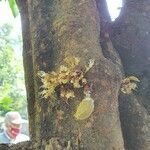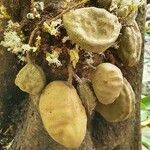A small tree. It grows up to 15 m high. It has a thick stem which branches many times. Each leaf is made up of two leaflets. The leaf is 5-15 cm long and 2.5-7.5 cm wide and is not the same shape in the two halves of the leaf. The leaves are shiny smooth and dark green on top and paler underneath. The flowers are small. They are 1.2 cm across. They appear on the stem in clusters. The fruit is a fleshy pod 5-10 cm long and 5 cm wide. It is kidney shaped. There is one seed. The fruit has a fleshy pulp. The flesh is yellow. The fruit surface is rough and wrinkled. It is a dull pale green.


